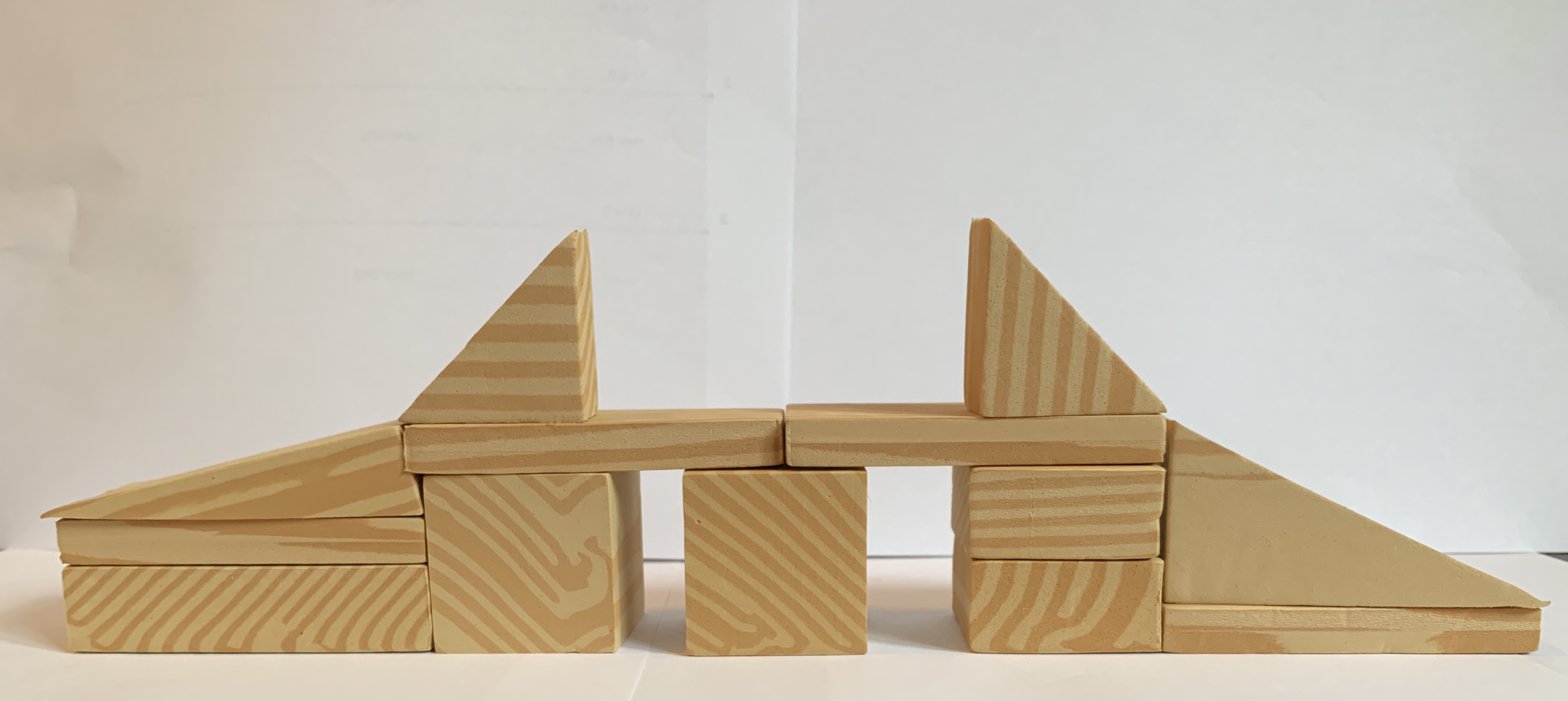Lesson 2
Build Shapes from Other Shapes
Warm-up: Notice and Wonder: A Shape Bridge (10 minutes)
Narrative
Launch
- Groups of 2
- Display the image.
- “What do you notice? What do you wonder?”
- 1 minute: quiet think time
Activity
- “Discuss your thinking with your partner.”
- 1 minute: partner discussion
- Share and record responses.
Student Facing
What do you notice?
What do you wonder?

Student Response
For access, consult one of our IM Certified Partners.
Activity Synthesis
- “What solid shapes do you see in this image?” (cube, triangle blocks, rectangle blocks)
- Display a triangular prism.
- “You saw some of these shapes in this image. It is called a triangular prism. Say triangular prism.”
- Display a rectangular prism.
- “You saw some of these shapes in this image. It is called a rectangular prism. Say rectangular prism.”
- Display each shape a few times and invite students to chorally repeat the names in unison 1–2 times:
- Rectangular prism
- Triangular prism
Activity 1: Build With Solid Shapes (15 minutes)
Narrative
Advances: Speaking, Conversing
Supports accessibility for: Attention, Social-Emotional Functioning
Required Materials
Materials to Gather
Launch
- Groups of 4
- Give each group geoblocks and solid shapes.
- Display a cube, cylinder, sphere, and cone.
- “What are the names of these solid shapes?” (cube, cylinder, sphere, and cone)
- 30 seconds: quiet think time
- Share responses. For each shape, ask the class to repeat the name of the shape.
Activity
- “Use the shapes to build a new object. You can build anything you want. Be sure you can describe your new object.”
- 5 minutes: independent work time
- “Show the object you built to your group. Describe what you made and what shapes you used.”
- 5 minutes: small group discussion
- Monitor for 3 or 4 objects to share during the synthesis.
Student Response
For access, consult one of our IM Certified Partners.
Activity Synthesis
- Invite previously identified students to share.
- “What shapes did they use to make their object?” (They used 4 cubes and 2 solid triangle blocks.)
- Repeat as time allows.
Activity 2: Use Shapes to Make Other Shapes (10 minutes)
Narrative
Required Materials
Materials to Gather
Launch
- Groups of 4
- Give each group geoblocks.
- Display a large cube.
- “This cube can be built from other shapes. See how many ways you can build a cube using other shapes.”
- 3 minutes: partner work time
- Share responses.
Activity
- “Choose a different shape. Try to find smaller shapes you can use to build that shape.”
- 5 minutes: partner work time
Student Response
For access, consult one of our IM Certified Partners.
Activity Synthesis
- Display a cube and a composite cube—for example, a cube composed of four small cubes and one rectangular prism.
- Demonstrate putting the shapes together.
- “What new shape did I make with the cube and the cube I made?”
- “Put your shapes together to make a rectangular prism.”
- Display a rectangular prism and two triangular prisms.
- “Find these shapes. Put them together. What new shape can you make?” (a cube, a rectangular block)
Activity 3: Introduce Geoblocks, Describe and Find (15 minutes)
Narrative
Required Materials
Materials to Gather
Launch
- Groups of 2
- Give each group 4-6 different geoblocks and solid shapes.
- “We are going to learn a new way to play Geoblocks, which is a center that was introduced in kindergarten.”
- “Put the solid shapes in the middle, between you and your partner.”
- 30 seconds: partner work time
- “Think of a shape but don’t tell your partner. Describe one of the shapes to your partner. Your partner’s job is to guess which shape you are describing. Once your partner figures out which shape you are describing, switch roles.”
Activity
- 10 minutes: partner work time
- Monitor for students who describe the shapes in different ways.
Activity Synthesis
- Invite previously identified students to share.
- “Which clues did your partner give that were helpful to you?” (My partner said the shape had a flat side that is a circle and it had a point on the other end.)
Lesson Synthesis
Lesson Synthesis
“Today we worked with solid shapes to make new shapes and objects. We also described shapes. What were some of the ways you described the shapes?” (I told my partner how many sides it had. I said what the shape of the sides were. I counted the points and told my partner how many.)
“Mai was describing a shape for her partner. She said the shape was hard and smooth. Do you think her partner will be able to find the shape she is describing? Why or why not?” (No because all of these shapes are hard and smooth. She didn’t describe the things that make her shape different than the other shapes.)
Cool-down: Unit 7, Section A Checkpoint (0 minutes)
Cool-Down
For access, consult one of our IM Certified Partners.